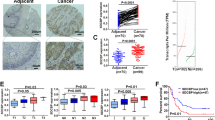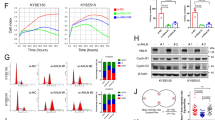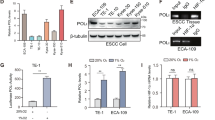Abstract
We have shown earlier that overexpression of Calreticulin (CRT) contributed to a poor prognosis for patients with esophageal squamous cell carcinoma (ESCC). Here, we have shown an important role of CRT in tumorigenesis through enhancing cell motility and anoikis resistance. SiRNA-mediated knockdown of CRT caused impaired cell migration, invasion and resistance to anoikis. Notably, CRT downregulation decreased the expression of Cortactin (CTTN), which has been previously reported as a candidate oncogene associated with anoikis through the PI3K–Akt pathway. In addition, Akt phosphorylation was abolished after CRT downregulation and its activation can be refreshed by CRT upregulation, suggesting that CRT-enhanced cell resistance to anoikis through the CRT–CTTN–PI3K–Akt pathway. Moreover, the CTTN mRNA level was decreased in CRT–siRNA cells, coupled with the inactivation of STAT3. Expression of both CTTN and p-STAT3 was reduced in tumor cells following incubation with the JAK-specific inhibitor, AG490. Chromatin immunoprecipitation assay showed direct binding of p-STAT3 to the conservative STAT3-binding sequences in CTTN promoter. Furthermore, overexpression of CTTN in CRT-downregulated ESCC cells restored its motility and resistance to anoikis. This study not only reveals a role of CRT in motility promotion and anoikis resistance in ESCC cells, but also identifies CRT as an upstream regulator in the CRT–STAT3–CTTN–Akt pathway.
This is a preview of subscription content, access via your institution
Access options
Subscribe to this journal
Receive 50 print issues and online access
$259.00 per year
only $5.18 per issue
Buy this article
- Purchase on Springer Link
- Instant access to full article PDF
Prices may be subject to local taxes which are calculated during checkout





Similar content being viewed by others
References
Alaiya A, Roblick U, Egevad L, Carlsson A, Franzen B, Volz D et al. (2000). Polypeptide expression in prostate hyperplasia and prostate adenocarcinoma. Anal Cell Pathol 21: 1–9.
Bini L, Magi B, Marzocchi B, Arcuri F, Tripodi S, Cintorino M et al. (1997). Protein expression profiles in human breast ductal carcinoma and histologically normal tissue. Electrophoresis 18: 2832–2841.
Bourguignon LY, Zhu H, Shao L, Chen YW . (2001). CD44 interaction with c-Src kinase promotes cortactin-mediated cytoskeleton function and hyaluronic acid-dependent ovarian tumor cell migration. J Biol Chem 276: 7327–7336.
Bowden ET, Barth M, Thomas D, Glazer RI, Mueller SC . (1999). An invasion-related complex of cortactin, paxillin and PKCmu associates with invadopodia at sites of extracellular matrix degradation. Oncogene 18: 4440–4449.
Chahed K, Kabbage M, Ehret-Sabatier L, Lemaitre-Guillier C, Remadi S, Hoebeke J et al. (2005). Expression of fibrinogen E-fragment and fibrin E-fragment is inhibited in the human infiltrating ductal carcinoma of the breast: the two-dimensional electrophoresis and MALDI-TOF-mass spectrometry analyses. Int J Oncol 27: 1425–1431.
Chen D, Texada DE, Duggan C, Liang C, Reden TB, Kooragayala LM et al. (2005). Surface calreticulin mediates muramyl dipeptide-induced apoptosis in RK13 cells. J Biol Chem 280: 22425–22236.
Chuma M, Sakamoto M, Yasuda J, Fujii G, Nakanishi K, Tsuchiya A et al. (2004). Overexpression of cortactin is involved in motility and metastasis of hepatocellular carcinoma. J Hepatol 41: 629–636.
Clark ES, Brown B, Whigham AS, Kochaishvili A, Yarbrough WG, Weaver AM . (2009). Aggressiveness of HNSCC tumors depends on expression levels of cortactin, a gene in the 11q13 amplicon. Oncogene 28: 431–444.
Coppolino MG, Woodside MJ, Demaurex N, Grinstein S, St-Arnaud R, Dedhar S . (1997). Calreticulin is essential for integrin-mediated calcium signalling and cell adhesion. Nature 386: 843–847.
Du XL, Hu H, Lin DC, Xia SH, Shen XM, Zhang Y et al. (2007). Proteomic profiling of proteins dysregulted in Chinese esophageal squamous cell carcinoma. J Mol Med 85: 863–875.
Eric A, Juranic Z, Milovanovic Z, Markovic I, Inic M, Stanojevic-Bakic N et al. (2009). Effects of humoral immunity and calreticulin overexpression on postoperative course in breast cancer. Pathol Oncol Res 1: 89–90.
Gold LI, Rahman M, Blechman KM, Greives MR, Churgin S, Michaels J et al. (2006). Overview of the role for calreticulin in the enhancement of wound healing through multiple biological effects. J Investig Dermatol Symp Proc 11: 57–65.
Hayashida Y, Urata Y, Muroi E, Kono T, Miyata Y, Nomata K et al. (2006). Calreticulin represses E-cadherin gene expression in Madin-Darby canine kidney cells via Slug. J Biol Chem 281: 32469–33284.
Helbling D, Mueller BU, Timchenko NA, Hagemeijer A, Jotterand M, Meyer-Monard S et al. (2004). The leukemic fusion gene AML1-MDS1-EVI1 suppresses CEBPA in acute myeloid leukemia by activation of Calreticulin. Proc Natl Acad Sci USA 101: 13312–13317.
Huang YH, Chang AY, Huang CM, Huang SW, Chan SH . (2002). Proteomic analysis of lipopolysaccharide-induced apoptosis in PC12 cells. Proteomics 2: 1220–1228.
Kageyama K, Ihara Y, Goto S, Urata Y, Toda G, Yano K et al. (2002). Overexpression of calreticulin modulates protein kinase B/Akt signaling to promote apoptosis during cardiac differentiation of cardiomyoblast H9c2 cells. J Biol Chem 277: 19255–19264.
Kim YM, Kim HJ, Song EJ, Lee KJ . (2004). Glucuronic acid is a novel inducer of heat shock response. Mol Cell Biochem 259: 23–33.
Kinley AW, Weed SA, Weaver AM, Karginov AV, Bissonette E, Cooper JA et al. (2003). Cortactin interacts with WIP in regulating Arp2/3 activation and membrane protrusion. Curr Biol 13: 384–393.
Li Y, Tondravi M, Liu J, Smith E, Haudenschild CC, Kaczmarek M et al. (2001). Cortactin potentiates bone metastasis of breast cancer cells. Cancer Res 61: 6906–6911.
Lim S, Chang W, Lee BK, Song H, Hong JH, Lee S et al. (2008). Enhanced calreticulin expression promotes calcium-dependent apoptosis in postnatal cardiomyocytes. Mol Cells 25: 390–396.
Lua BL, Low BC . (2005). Cortactin phosphorylation as a switch for actin cytoskeletal network and cell dynamics control. FEBS Lett 579: 577–585.
Luo ML, Shen XM, Zhang Y, Wei F, Xu X, Cai Y et al. (2006). Amplification and overexpression of CTTN (EMS1) contribute to the metastasis of esophageal squamous cell carcinoma by promoting cell migration and anoikis resistance. Cancer Res 66: 11690–11699.
Mesaeli N, Phillipson C . (2004). Impaired p53 expression, function, and nuclear localization in calreticulin-deficient cells. Mol Biol Cell 15: 1862–1870.
Michalak M, Burns K, Andrin C, Mesaeli N, Jass GH, Busaan JL et al. (1996). Endoplasmic reticulum form of calreticulin modulates glucocorticoid-sensitive gene expression. J Biol Chem 271: 29436–29445.
Michalak M, Corbett EF, Mesaeli N, Nakamura K, Opas M . (1999). Calreticulin: one protein, one gene, many functions. Biochem J 344 (Part 2): 281–292.
Nishimori T, Tomonaga T, Matsushita K, Oh-Ishi M, Kodera Y, Maeda T et al. (2006). Proteomic analysis of primary esophageal squamous cell carcinoma reveals downregulation of a cell adhesion protein, periplakin. Proteomics 6: 1011–1018.
Okunaga T, Urata Y, Goto S, Matsuo T, Mizota S, Tsutsumi K et al. (2006). Calreticulin, a molecular chaperone in the endoplasmic reticulum, modulates radiosensitivity of human glioblastoma U251MG cells. Cancer Res 66: 8662–86671.
Pallero MA, Elzie CA, Chen J, Mosher DF, Murphy-Ullrich JE . (2008). Thrombospondin 1 binding to calreticulin-LRP1 signals resistance to anoikis. FASEB J 22: 3968–3979.
Rauch F, Prud’homme J, Arabian A, Dedhar S, St-Arnaud R . (2000). Heart, brain, and body wall defects in mice lacking calreticulin. Exp Cell Res 256: 105–111.
Rothschild BL, Shim AH, Ammer AG, Kelley LC, Irby KB, Head JA et al. (2006). Cortactin overexpression regulates actin-related protein 2/3 complex activity, motility, and invasion in carcinomas with chromosome 11q13 amplification. Cancer Res 66: 8017–8025.
Shago M, Flock G, Leung Hagesteijn CY, Woodside M, Grinstein S, Giguere V et al. (1997). Modulation of the retinoic acid and retinoid X receptor signaling pathways in P19 embryonal carcinoma cells by calreticulin. Exp Cell Res 230: 50–60.
Tatu U, Helenius A . (1997). Interactions between newly synthesized glycoproteins, calnexin and a network of resident chaperones in the endoplasmic reticulum. J Cell Biol 136: 555–565.
Valentijn AJ, Zouq N, Gilmore AP . (2004). Anoikis. Biochem Soc Trans 32: 421–425.
Vanoverberghe K, Vanden Abeele F, Mariot P, Lepage G, Roudbaraki M, Bonnal JL et al. (2004). Ca2+ homeostasis and apoptotic resistance of neuroendocrine-differentiated prostate cancer cells. Cell Death Differ 11: 321–330.
Vougas K, Gaitanarou E, Marinos E, Kittas C, Voloudakis-Baltatzis IE . (2008). Two-dimensional electrophoresis and immunohistochemical study of calreticulin in colorectal adenocarcinoma and mirror biopsies. J BUON 13: 101–107.
Weaver AM . (2008). Cortactin in tumor invasiveness. Cancer Lett 265: 157–166.
Zhang Y, Zhang M, Dong H, Yong S, Li X, Olashaw N et al. (2009). Deacetylation of cortactin by SIRT1 promotes cell migration. Oncogene 28: 445–460.
Acknowledgements
We thank Professor Simon J Harris for the English revision of the article. This study was supported by National Basic Research Program of China (2004CB518705), National High-tech R&D Program of China (2006AA02A403), National Key Technologies R&D Program of China (2006BAI02A14), Specialized Research Fund for the Doctoral Program of Higher Education of China (20060023003) and National Natural Science Foundation (30872936, 30721001).
Author information
Authors and Affiliations
Corresponding author
Rights and permissions
About this article
Cite this article
Du, XL., Yang, H., Liu, SG. et al. Calreticulin promotes cell motility and enhances resistance to anoikis through STAT3–CTTN–Akt pathway in esophageal squamous cell carcinoma. Oncogene 28, 3714–3722 (2009). https://doi.org/10.1038/onc.2009.237
Received:
Revised:
Accepted:
Published:
Issue Date:
DOI: https://doi.org/10.1038/onc.2009.237
Keywords
This article is cited by
-
A risk prognostic model for patients with esophageal squamous cell carcinoma basing on cuproptosis and ferroptosis
Journal of Cancer Research and Clinical Oncology (2023)
-
Calreticulin as a marker and therapeutic target for cancer
Clinical and Experimental Medicine (2022)
-
Prognostic association of starvation-induced gene expression in head and neck cancer
Scientific Reports (2021)
-
Calreticulin promotes EMT in pancreatic cancer via mediating Ca2+ dependent acute and chronic endoplasmic reticulum stress
Journal of Experimental & Clinical Cancer Research (2020)
-
Calreticulin mediates an invasive breast cancer phenotype through the transcriptional dysregulation of p53 and MAPK pathways
Cancer Cell International (2016)



